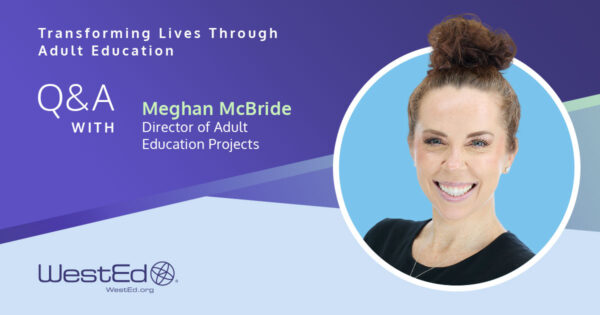
July 18, 2025
By Rajinder Gill and Erin Carter
In this blog series, we’ll share actionable tips and information about the skills-first hiring movement; its implications for learners, workers, and employers; and the benefits of adopting a skills-based mindset.
More than half of U.S. state governments have enacted legislation or executive orders encouraging skills-first hiring, including the elimination of degree requirements for many public sector job postings and/or the shift to a more comprehensive review of candidates’ work experience and nondegree training during the hiring process.
In this first post in the series, we answer key questions about skills-first hiring and explore how WestEd works with employers and educators on this emerging shift to put skills at the center in both hiring and education settings.
What is skills-first hiring?
Skills-first hiring, also referred to as skills-based hiring, is a process that moves away from the traditional focus on education, previous employers, years of experience, and job titles as indicators of a candidate’s capabilities during the application and interview process or even during performance evaluations. Instead, it focuses on the specific skills needed to do the actual job for which an employer is hiring.
The U.S. Chamber of Commerce Foundation provides a definition for skills-based hiring as “the practice of evaluating a candidate beyond education credentials … and experience requirements to assess a candidate’s unique skills, abilities and demonstrated competencies.”
As the Journal of Social Issues explains, the value in this approach is that it addresses an urgent need to shift “specific employment processes (such as interviewing, performance evaluation, or succession planning) that unintentionally amplify bias by favoring candidates with more traditional educational backgrounds.
This does not indicate that degree attainment is devalued but instead helps ensure that the lack of an advanced degree is not the means by which candidates get screened out of the hiring process. Instead, candidates are screened in through a lens of what skills they possess.
Given the rise in individuals who are working while enrolled in certification or degree programs, this opens up opportunities for income generation that can support lifelong learning and increasing levels of economic mobility.
Why do we need skills-first hiring?
Both in the United States and around the world, we find ourselves in a time period of rapid and pervasive change. The rise of AI-based technology, digital platforms designed to allow individuals to directly curate and share their education and employment information, and shifting economies hold both promise and pitfalls if we do not adopt a nimble and forward-thinking approach.
According to ManpowerGroup, 74 percent of employers globally cannot fill their open positions, yet a recent survey from Harvard Business School confirmed that 88 percent of hirers agree that they are filtering out highly skilled candidates just because they lack traditional credentials such as past job title or degree.
Opportunity@Work, a nonprofit organized around the two primary goals of exploring “tech-enabled solutions to solve the opportunity gap” and being a convener of “public, private, and nonprofit partners to rewire the labor market so that everyone can contribute their skills, talent, and energy in pursuit of a better life,” has defined this broader pool of job seekers as Skilled Through Alternative Routes, or STARS. These individuals have participated in activities like on-the-job training, military service, or community college, making them ideal candidates for skills-first hiring.
To maintain a robust economy—in which learners can exit education or training settings and quickly enter or reenter the workforce and in which employers have access to hiring pools with a broad range of eligible candidates—skills can function as the glue connecting multiple systems from secondary to postsecondary education, workforce development, and HR/recruiting. This shift helps employers hire qualified candidates faster and connects job seekers with opportunities that complement their skills and experiences rather than their credentials exclusively.
What are transferable skills?
You may have heard of the term “transferable skills,” or those skills that can apply across any job type or industry. At WestEd, we understand that EVERY skill is transferable. Whether a skill has been learned and developed in a formal education setting, in a workforce training session, through the military, on the job, or through navigating life in general, these experiences are all part of what we holistically bring into work settings.
These skills can be a mix of both “technical” skills—the specific, job-critical capabilities required to execute core tasks—and “soft” skills, a term that has been used historically to indicate the interpersonal and intrapersonal skills that are deemed essential for success in both education and career settings, such as communication, collaboration, and problem-solving. The latter are now more frequently referred to as “durable” skills, a term popularized by America Succeeds, which conducted an analysis of 80 million job postings from 2020 to 2021 to “reveal that 7 of the 10 most requested skills are durable skills.”
To learn more about durable skills, why employers value them, and how educators and workforce trainers can help develop these skills in learners and job seekers, watch our recent panel discussion, hosted by the Chronicle of Higher Education.
How does WestEd help employers and educators focus on skills?
At WestEd, we are taking a close look at what it actually means to focus on skills. Harvard Business School and Burning Glass published an analysis in early 2024 that showed that even employers who wanted to use skills-first hiring face challenges in making the change. Since then, a series of resources and toolkits have been released to help guide the process. Many of them offer conceptual change-management guidance that, although robust and valuable, can be time-consuming to enact. Additionally, many educators are embracing a competency-based focus to curriculum development, meaning they are intentionally deciding how to embed skills education into their coursework, while trying to navigate traditional processes for course approval that can be a lengthy process.
Keeping in mind that call to action for a nimble approach, WestEd’s Center for Economic Mobility has developed a simple framework to correlate specific skills with associated tasks (for work settings) or skills related to activities/assignments (for education settings). This framework can help guide employers in writing skills-based job postings and interview questions and can help educators make explicit connections that expand student learning outcomes, the measurable statements that define what students should know upon the completion of a course or program down to the skill level.
If you wish to learn more, we encourage you to follow our work through this blog series, where we will take a deeper dive into our Skills at the Center Employer Workshops, share our emerging work supporting educators as they embed the language of skills into their coursework, and showcase free resources to help support you in your skills journey.
Reach out to us directly if you’d like to learn more!
Rajinder Gill is a program manager at WestEd’s Center for Economic Mobility, where she brings her extensive background in skills-based curriculum development and training through the New World of Work and Essential Skills Programs to her current focus on Learning and Employment Records (LERs), digital badges, competency-based education, and skills-first hiring.
Erin Carter is a program manager in WestEd’s Improvement Science content area working on projects that address the use of technology to support institutional goals and documenting effective implementation stories. She conducts research on emerging technologies used to support the skills-based hiring movement.










